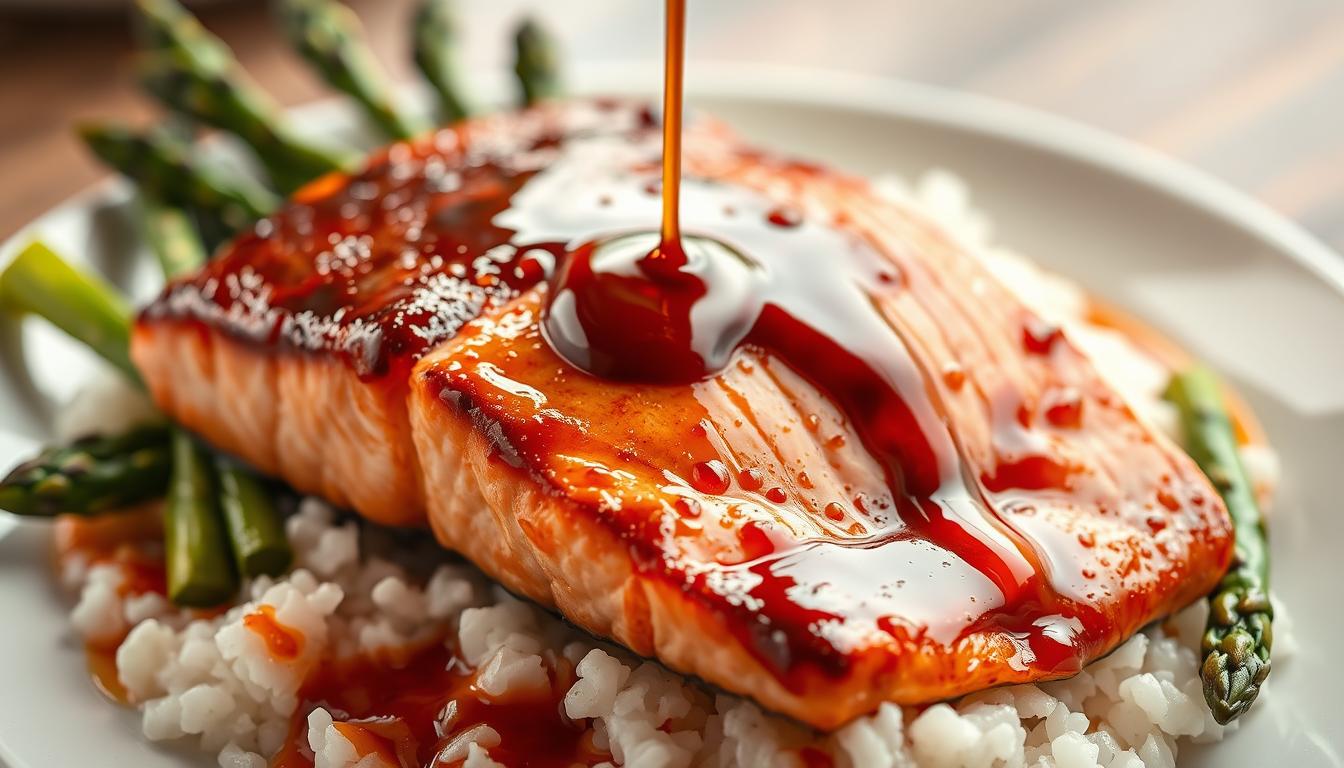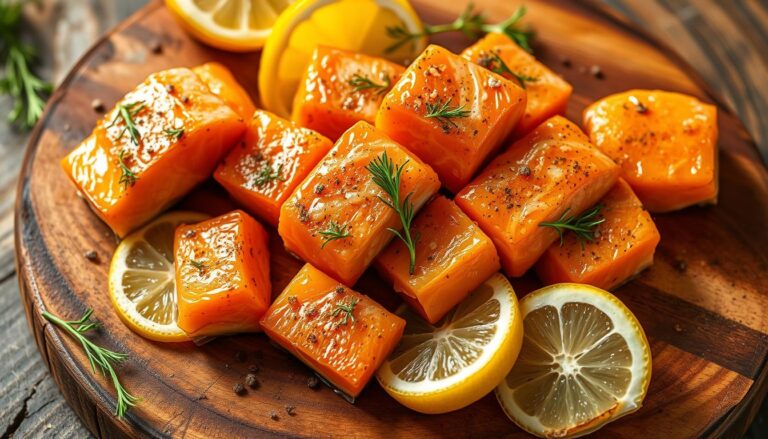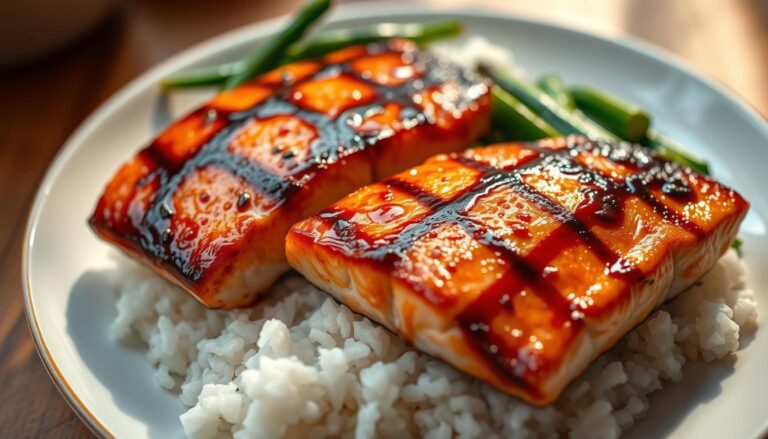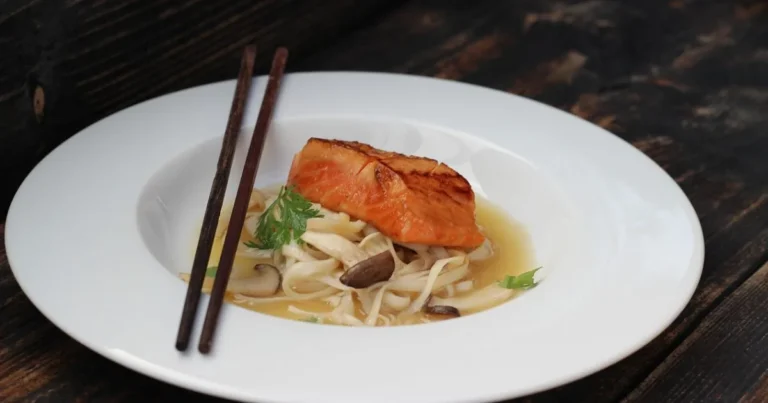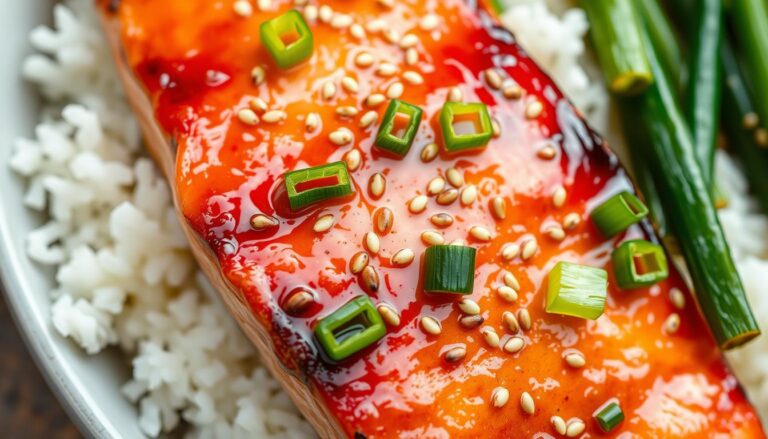Tender Teriyaki Glazed Salmon: A Healthy Dinner Option
You’ve had nights when you want a quick, comforting meal that still feels special. This honest, weeknight-friendly recipe gives you that—without hours of fuss or a long marinade.
This dish delivers big flavor with simple steps. You build a glossy sauce on the stovetop from soy, brown sugar, rice wine vinegar, garlic, and ginger, thicken it briefly, and finish the fish so it stays juicy and flaky.
You’ll get a balanced meal rich in protein and omega-3 fat, brightened by sliced green onions and sesame at the end. Bake at 400°F for a hands-off approach, pan-sear for crispy edges, or grill when you want smoke.
This recipe shows how to choose the right fillet, adjust time for thickness, and swap in Tamari for gluten-free cooking. In minutes you’ll have a satisfying plate that feels both homey and impressive.
Table of Contents
Why You’ll Love This Teriyaki Glazed Salmon for a Weeknight Dinner
You can get a dinner that feels special with minimal fuss—just a short bake, a bright sauce, and a quick broil. The oven method at 400°F yields flaky fish in roughly 10–16 minutes depending on thickness. A final broil gives a restaurant-style sheen that makes the plate look finished.
This salmon recipe works fast and reliably. Use wild-caught Sockeye for lean, quicker cooking, or choose a fattier farmed fillet for extra forgiveness during baking. Swap in low-sodium Tamari to keep salt down while preserving classic taste.
- You’ll have a complete meal in under 30 minutes with rice and steamed veggies.
- The sauce balances sweet and savory notes so it clings to the fish and adds bold flavor.
- The method scales easily, reheats well, and adapts to baking, searing, or grilling.
Finish with sesame and green onions for texture, and adjust sweetness to your taste.
Ingredients for Homemade Teriyaki Glazed Salmon
Start with quality fish and pantry staples to build a sauce that clings and shines.
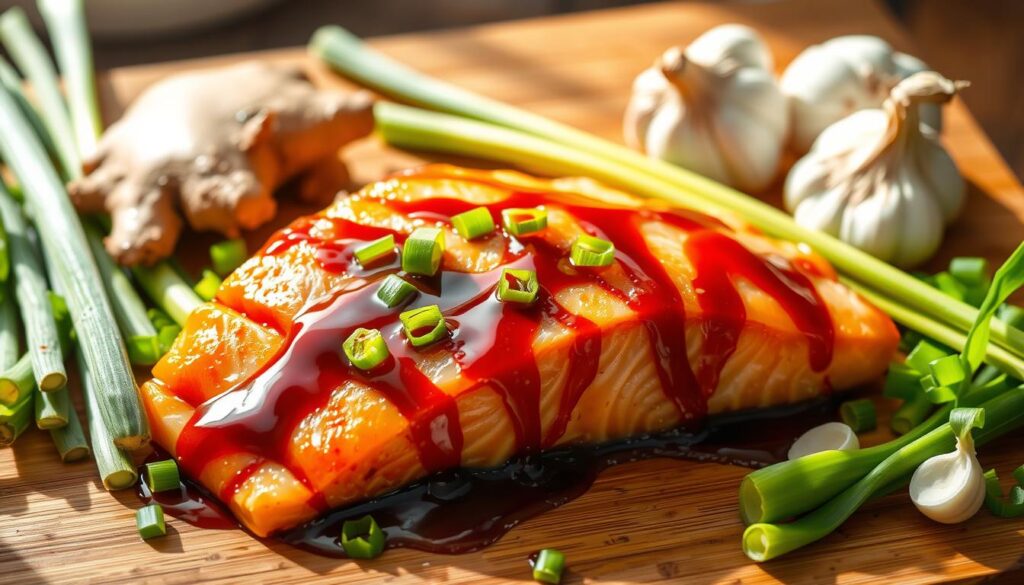
Salmon fillets: choosing wild vs. farmed
Pick salmon fillets sized for even cooking. Wild fillets are leaner and cook faster. Farmed fillets are thicker and more forgiving, so they stay moist under heat.
Core sauce components
For about 1.5–2 lb salmon: combine 1/2 cup soy sauce, 1/4 cup brown sugar, and 1/2 tablespoon rice wine vinegar. Whisk in minced garlic and fresh ginger. Simmer until slightly reduced.
Aromatics, thickener, and brighteners
Add 6 oz pineapple juice for bright sweetness if you like. Thicken the mixture with a cornstarch-and-water slurry made in a small bowl so the glaze coats a spoon.
Garnishes and swaps
Finish with sesame seeds and chopped green onions for texture. Use low-sodium soy or Tamari to lower salt. Reserve half the marinade for cooking and keep the rest separate for serving.
Oven-Baked Method: Simple Teriyaki Glazed Salmon Recipe
This oven method keeps things hands-off while locking in flavor and shine. Preheat the oven to 400°F and line a rimmed sheet with foil. Lightly grease the foil and pat the fillets dry so the sauce sticks.
Prep and preheat
Set the oven to 400°F and place the sheet on the upper rack. Pat each fillet dry with paper towels. Greasing the foil prevents sticking and helps you lift the fish off the sheet cleanly.
Make the sauce
Whisk soy, brown sugar, rice wine vinegar, minced ginger, and garlic in a bowl. Simmer 5 minutes, add a cornstarch-and-water slurry and 6 oz pineapple juice, then simmer another 5–10 minutes.
Cook until the sauce coats a spoon and has a glossy, pourable texture.
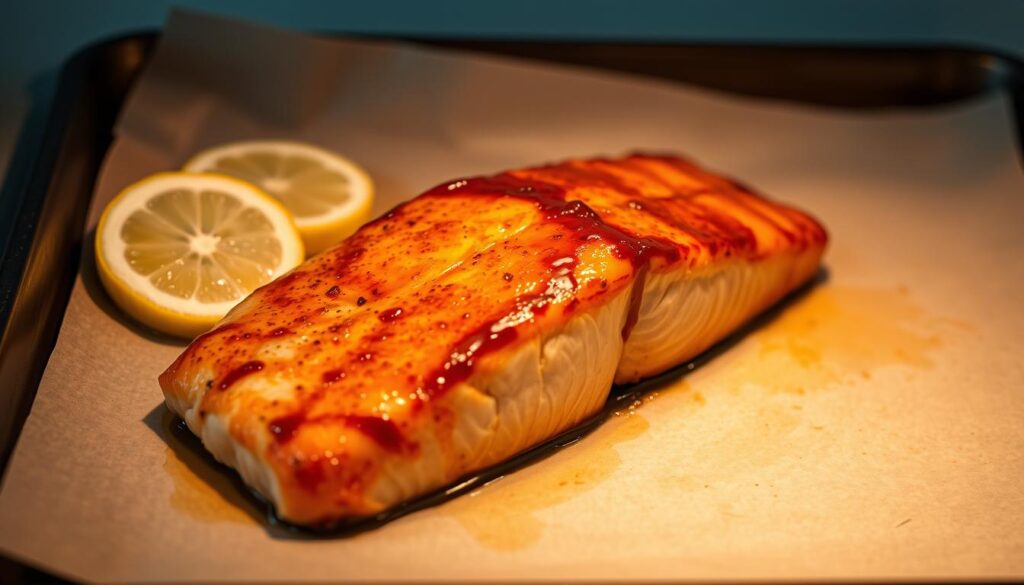
Teriyaki Glazed Salmon
Bake, glaze, and broil
Spoon the sauce over fillets and bake on the upper rack 10–12 minutes. For thicker pieces, bake 12–16 minutes. Brush a fresh layer on top, then broil 2–3 minutes for a lacquered finish.
“Keep a close eye during broiling so the top turns glossy, not burnt.”
Rest briefly, garnish with green onions and sesame seeds, and serve with pan juices for the best texture and taste.
Easy Variations: Pan-Fried, Grilled, and Time-Saving Tips
Choose the cooking path that matches your time: a fast skillet, a steady grill, or a hands-off oven. Each method uses the same core flavors so you can adapt based on schedule and craving.
Pan sear for a quick finish
Marinate briefly—about 15–30 minutes—then heat a thin film of oil in a hot pan. Sear fillets 3–4 minutes per side to get a crisp exterior and tender interior.
Tip: Split the marinade so half stays raw for marinating and half is simmered into teriyaki sauce. Thicken the reserved glaze with a cornstarch slurry to spoon over the seared pieces.
Grill for smoky layers
Preheat the grill to 400°F and brush with the reserved sauce while cooking. Grill 8–12 minutes, turning and basting to build glossy layers without flare-ups.
Know your baking times
Bake at 400°F when you want hands-off cooking. Wild varieties cook faster; farmed, thicker fillets can take longer—aim for opaque flesh that flakes with gentle pressure rather than strict minutes alone.
“Make teriyaki ahead and store chilled so busy weeknights feel easier.”
- Season lightly with soy and finish with green onions and sesame.
- Spoon sauce over rice to soak up drippings and complete the plate.
Nutrition, Serving Ideas, and Make-Ahead Storage
This baked portion gives you quality protein and heart-healthy omega‑3s while letting you manage salt by swapping to low-sodium soy or Tamari.
Nutrition snapshot: protein, healthy fats, and sodium awareness
You get a solid protein hit and beneficial fats in each serving. Those nutrients support muscle and heart health. Watch sodium if you use regular soy; low-sodium options cut salt without losing depth.
Storage and reheating: refrigerate, glaze holdback, gentle reheat
Store leftovers in a shallow container in the fridge. Hold back half the glaze before cooking so you have a fresh portion for serving.
Reheat gently over low heat and brush on a thin layer of sauce to keep the fish moist.
What to serve with it: rice, veggies, and sesame-studded toppings
Pair the fillet with steamed rice and roasted or steamed vegetables for a complete meal. Portion a small bowl of extra sauce at the table so everyone controls how much they add.
Finish plates with sesame and a sprinkle of sesame seeds plus chopped green onions for crunch, aroma, and a vitamin boost.
| Item | Benefit | Serving tip |
|---|---|---|
| Rice | Soaks up sauce and adds carbs | Serve 1 cup per person |
| Vegetables | Provide vitamins and fiber | Roast or steam for color |
| Reserved sauce | Maintains moisture and flavor | Warm in a small bowl before serving |
| Garnish | Texture and aroma (sesame, seeds, green onions) | Sprinkle just before plating |
“Prep ingredients ahead to shave time and make weeknight plates come together fast.”
Conclusion
A quick oven run and a spooned-on sauce give you consistent, flavorful results every weeknight. Preheat oven to 400°F, line a sheet with foil, and bake 10–16 minutes depending on thickness.
Simmer the reserved marinade with brown sugar, soy sauce, rice vinegar, garlic, and ginger until glossy. Brush the sauce on top and broil briefly to set the finish without drying the fish.
Use the same approach for a pan or grill if you want crisp edges or smoky notes. This glazed salmon recipe and teriyaki salmon recipe scale easily, so you can assemble ingredients in a small bowl and finish in minutes.
Serve with seeds or green onions and a bowl of warm sauce for a reliable, home-cooked dinner you’ll make again and again.

